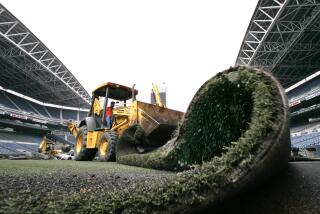SCHOOL DAYS
- Share via
Professional football players plant 56 cleat dents in every square foot of the gridiron during an average game. That statistic was one of many unearthed by UC Riverside researcher Steve Cockerham in his quest for the perfect playing field.
“The 40-yard line is the worst for wear and tear,” says Cockerham, 53. “Sometimes it’s hard to get anything to grow in that zone.” After studying the damage done by dozens of skirmishes, he designed a device to mimic athletes’ shearing and compacting action. Pulled by a garden tractor, the contraption, named for the mechanic who built it, runs up and down the dozens of varieties of grass on the six-acre test field operated by the school’s turf research program. Cockerham and his staff of four then determine which grasses are the hardiest, seeking turf with optimal cushioning and durability. They are especially concerned with safety. “The right grass minimizes bare spots and clumps of turf that cause athletes to twist ankles,” he says.
The university gets a patent for thegrasses UC researchers develop and then
sells the rights to sod growers. Stadiums around the world have sought Cockerham’s expertise. For the San Firo in Milan, Italy, he recommended less water, reseeding and a revamp of the drainage system.
Even the toughest grass is going to give eventually. “Not only do teams use fields, but so do hordes of band members with tubas. Then you figure in all those mascots and cheerleaders--that’s a lot of pounding.”
More to Read
Go beyond the scoreboard
Get the latest on L.A.'s teams in the daily Sports Report newsletter.
You may occasionally receive promotional content from the Los Angeles Times.










